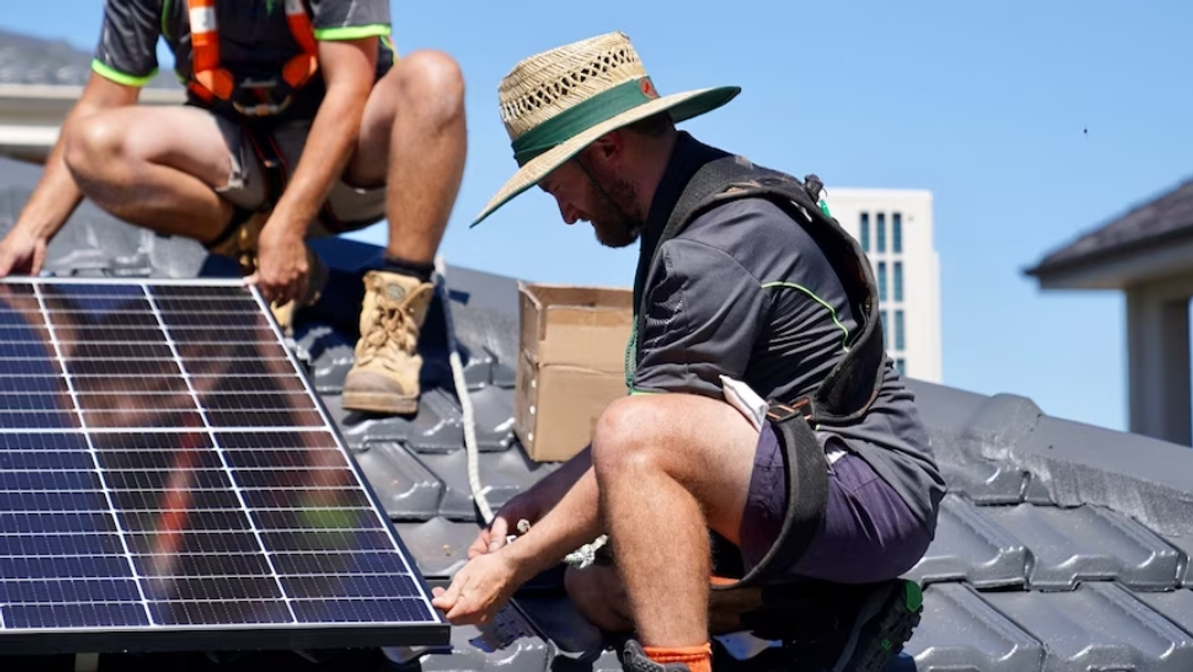Twelve new network-connected batteries will be installed across Queensland. What does it mean for the average household?
Premier Steven Miles said Queensland is yet to make the most of its enthusiastic embrace of rooftop solar.(ABC News: Glyn Jone)
A dozen new community batteries are being installed in Queensland with the promise of "cheap, renewable energy".
This week, Premier Steven Miles announced the government had committed $179 million to expand the local network-connected batteries program.
The scheme, first announced in 2021, works by harvesting solar energy collected by rooftop panels during the day and storing it in communal, grid-sized batteries.
During peak usage times in the evening, households draw on the stored energy to alleviate pressure on the electricity network.
But will this network help to lower power bills for the average Queensland household?
What is a community battery network?
Mr Miles said Queenslanders' enthusiastic adoption of rooftop solar had not yet been fully utilised.
"Each one of these batteries hold the equivalent power of a household's annual usage … that gives you a sense of how powerful each one of these batteries is," he said.
"Those with rooftop solar will be feeding into that battery, but everyone in that local community will be drawing down on it in the evenings."
Five lithium-ion batteries were installed in the project's first stage, and the installation of another dozen is underway.
The community batteries are spread across the state — in Townsville, Mackay, Bundaberg, Toowoomba and Brisbane.
Another fourteen batteries will come in stages three and four, with potential sites including Barcaldine, Mooloolaba and Jimboomba.
Construction is due to begin from mid-2025.
This will include a trial of two flow vanadium batteries, which promise increased energy storage capacity and a longer lifetime.
"It's one of the ways that we can help keep power prices down into the future," Mr Miles said.
What does this mean for households?
The current program is focused on powering suburbs, with 29 batteries to eventually make up the network.
Denyce Fisher from Energy Queensland said the technology has the potential to eventually power entire cities.
"What these batteries will do is help support the network in soaking up that solar power and also help balancing out the peak load towards the end of the day," she said.
Although you don't have to have solar panels to benefit, those who do will see bigger rewards, she said.
"It's a little bit more complicated than seeing a reduction in a bill," Ms Fisher said.
"If people were able to adopt solar at a greater rate, they would certainly see a reduction in their bills.
"The primary way that these batteries can support people's electricity bills is by enabling them to take on more solar."
Can it help households that don't have solar?
The director of Queensland University of Technology's Energy Storage Research Centre Group, Joshua Watts, said community batteries will make power more reliable during peak times.
"It's key to stabilising the grid," Dr Watts said.
"The sun doesn't shine at night so solar doesn't work at night and the wind isn't always blowing.
"This is becoming more and more important as we start moving towards more net-zero technologies, especially shutting down coal fired power."
Dr Watts said the extension of the battery network is a critical step in helping Queensland reach its emission reduction target of 70 per cent renewable energy by 2030, with the goal of net zero emission by 2050.
"We need to look at other energy storage technologies and their performance and how best they can be integrated into the electricity grid," he said.
"It's really important to test the different systems so we can vet the technologies and identify the most cost-effective solution."
Recent Posts
-
Oxford PV, Fraunhofer ISE achieve ‘record-breaking efficiency’ for PV module
Solar cell developer Oxford PV and Fraunhofer ISE have successfully developed a full-sized tandem PV …1st Feb 2024 -
New research shows impact of dust on PV module temperature, performance
New research from Pakistan shows that dust could reduce PV panel performance through the shielding e …1st Feb 2024 -
Chinese PV Industry Brief: JinkoSolar, Arctech unveil 2023 earnings forecasts
JinkoSolar says it expects a 2023 net profit ranging between CNY 7.25 billion ($1.02 billion) and CN …1st Feb 2024




